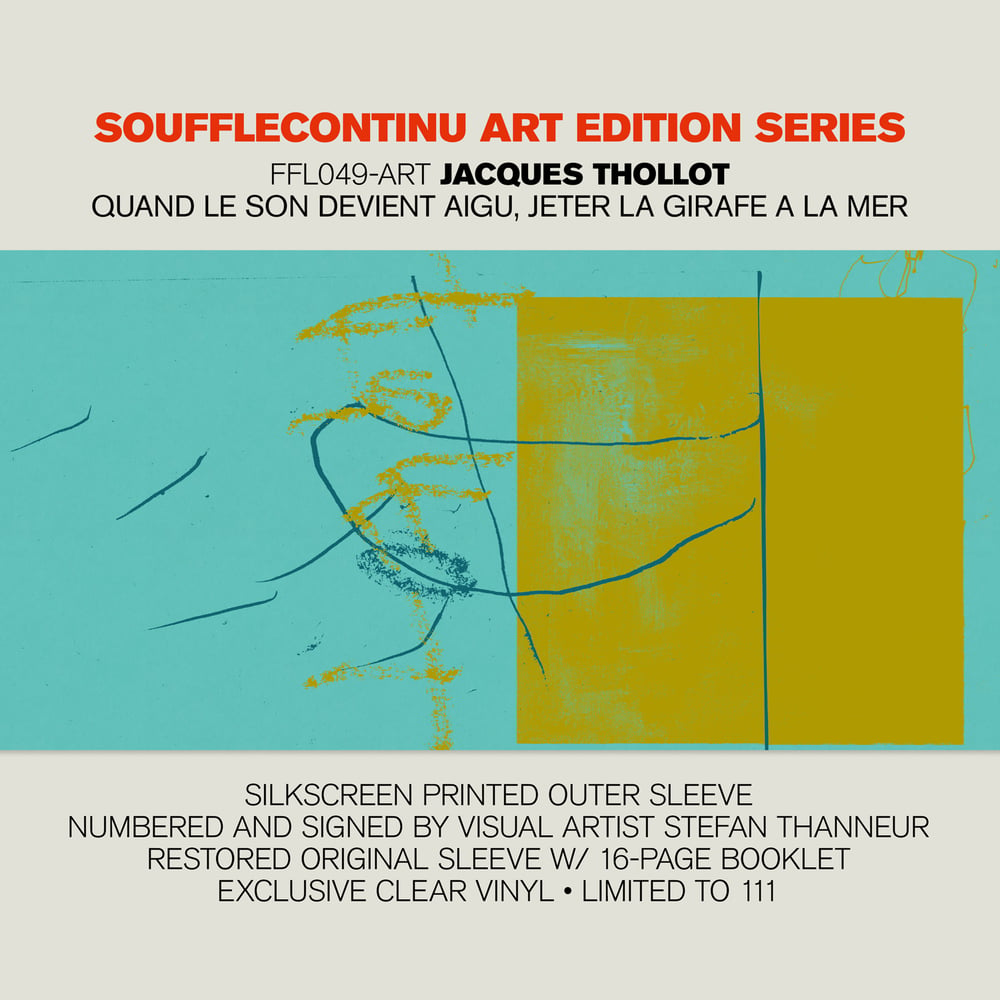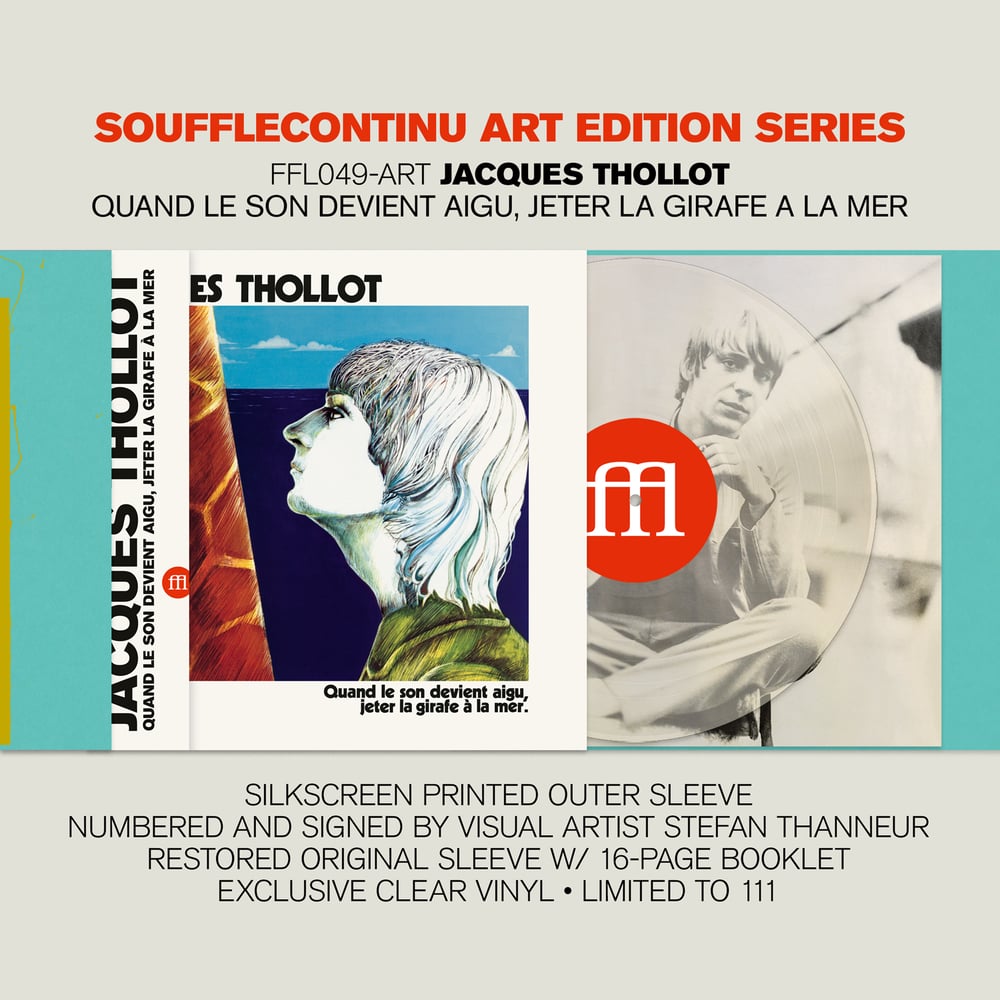JACQUES THOLLOT - Quand le son devient aigu, jeter la girafe à la mer - ART EDITION (FFL049-ART)
35,00 €
ART EDITION
SILKSCREEN PRINTED OUTER SLEEVE
NUMBERED AND SIGNED BY VISUAL ARTIST STEFAN THANNEUR
RESTORED ORIGINAL SLEEVE W/ 16-PAGE BOOKLET
EXCLUSIVE CLEAR VINYL * LIMITED TO 111
While he was still just a young adolescent who had perfected his drum technique under the benevolent wing of Kenny Clarke, the Club Saint-Germain liked to present Jacques Thollot as a prodigy capable of holding his own with the famous jazz musicians who came through Paris. It was there that Eric Dolphy immediately noticed him, and from René Thomas to Walt Dickerson, everyone wanted to work with him. However, it was during the 1960s, first with Jef Gilson then François Tusques, Barney Wilen, Joachim Kühn and Steve Lacy, that the decisive encounters occurred. Without forgetting that he joined, in 1968, one of Don Cherry’s groups, went on tour with them and came back transformed. That being said, to present Jacques Thollot as an in-demand virtuoso who could adapt to any circumstances would be to ignore both his demanding compositions and his complete freedom from stylistic boundaries. To prove the point, and although he had already featured on some cult albums (Our Meanings And Our Feelings by Michel Portal, Monkey-Pockie-Boo by Sonny Sharrock), the first album under his own name, recorded in 1971 for producer Gérard Terronès, who gave him free rein, would turn out to be an unexpected, unclassifiable and astounding work. Entitled Quand le son devient aigu, jeter la girafe à la mer, (when the sound gets high-pitched, throw the giraffe into the sea) it is an extraordinary sonic collage, created from discrete re-recordings and using just a handful of instruments including drums and piano. The result is a miracle, though the economy of means the production technique succeeds in putting the spotlight on the oddly elaborate compositions under an enigmatic but well-chosen title, borrowed from poet Henri Michaux. It puts into words the mysteries of a fragile melancholic universe which can be compared to another album by an iconoclastic drummer: The End Of An Ear by Robert Wyatt. The difference being the highly personal elements which shine through the French musician’s album, clearly drawn from listening intently to classics from Debussy, Ravel and Barraqué (whom he knew), a seam which he would continue to mine on his equally excellent following albums Watch Devil Go and Cinq Hops. Yes, it is true that Jacques Thollot recorded rarely under his own name (five albums during his lifetime), but what marvellous albums they are!
*
Alors qu'il n'est encore qu'un jeune adolescent au jeu de batterie perfectionné aux côtés du bienveillant Kenny Clarke, le Club Saint-Germain aime présenter Jacques Thollot comme un prodige capable de croiser le fer avec les grands noms du jazz de passage à Paris. Sur place, Eric Dolphy le repère immédiatement, et de René Thomas à Walt Dickerson, l'on s'arrache ses services. Mais au fil des années 1960, c'est avec Jef Gilson d'abord, puis François Tusques, Barney Wilen, Joachim Kühn et Steve Lacy, que les rencontres déterminantes ont lieu. Sans oublier son intégration dès 1968 à l'un des orchestres de Don Cherry, qu'il suit en tournée pour en revenir métamorphosé. Cependant, présenter Jacques Thollot comme un instrumentiste virtuose tout-terrain et très demandé, ne dit rien de ses exigences artistiques de compositeur, ni de sa liberté sans frontières stylistiques. Pour preuve, alors que des collaborations à des albums cultes figurent déjà à son palmarès (Our Meanings And Our Feelings de Michel Portal, Monkey-Pockie-Boo de Sonny Sharrock), son premier disque réalisé en 1971 sous son seul nom, et sous la houlette du producteur Gérard Terronès qui lui laisse carte blanche, se révèle être, de manière inattendue, une oeuvre inclassable et foudroyante. Intitulée Quand le son devient aigu, jeter la girafe à la mer, celle-ci se présente comme un collage sonore peu commun, confectionné à partir de re-recordings discrets ne sollicitant qu'une poignée d'instruments dont une batterie et un piano. Miracle, en visant à l'économie des moyens, ce mode de production réussit à magnifier des compositions étrangement tarabiscotées et au diapason d'un titre énigmatique mais bien choisi : emprunté au poète Henri Michaux, il traduit sous forme de mots les mystères d'un univers mélancolique et fragile, à rapprocher d'un autre grand disque de batteur iconoclaste : The End Of An Ear de Robert Wyatt. À cette différence près que, chez le Français, brille quelque chose d'éminemment personnel, vraisemblablement hérité d'écoutes assidues des classiques Debussy, Ravel et Barraqué (qu'il a côtoyé), veine que prolongent par la suite les non moins géniaux Watch Devil Go et Cinq Hops. Certes, Jacques Thollot a peu enregistré sous son seul nom (cinq disques de son vivant), mais quelles merveilles !
First ever vinyl reissue of this iconic recording
Remastered from the original tapes
16 page booklet with unpublished photos an an essay by Jean Rochard
.33rpm.
©2019 SouffleContinu Records
Licenced from Futura / Marge
-
If you want registered shipping,
please contact us at:
[email protected]
We can’t guarantee delivery or refund without registered shipping. Sorry about that.




